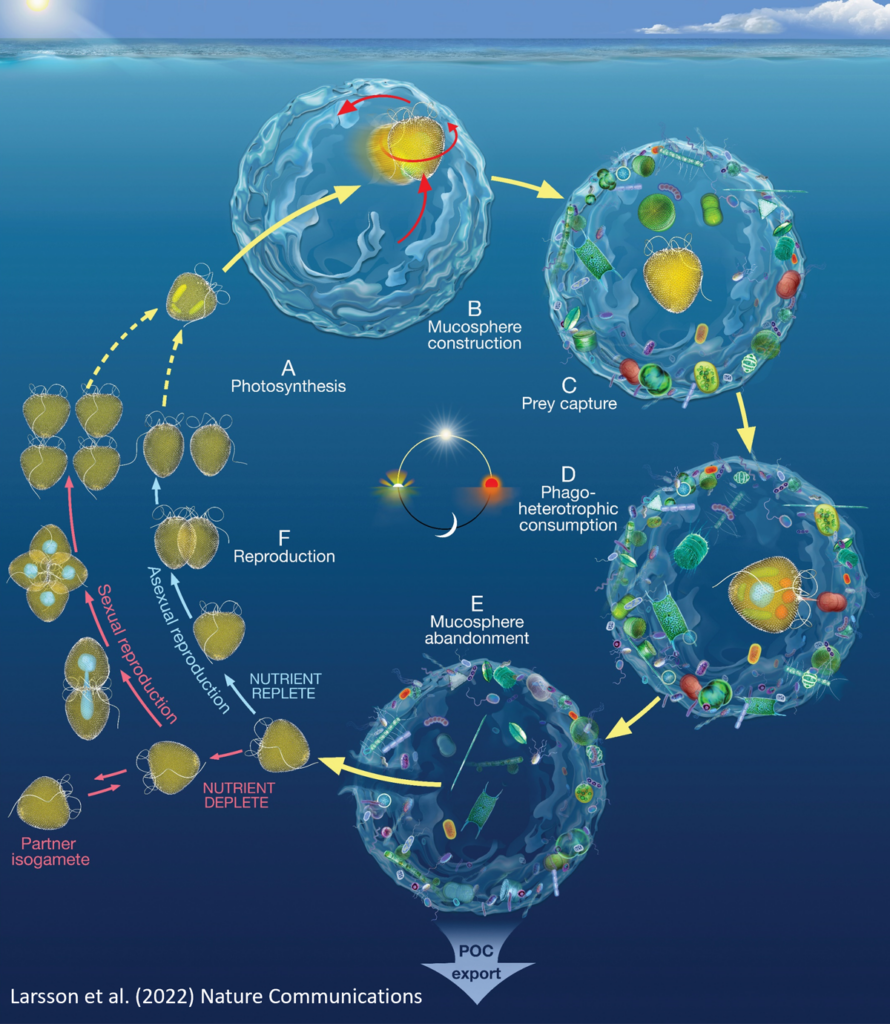The ocean plays a critical role in carbon sequestration. Phytoplankton, which live on the warm, light-filled surface, suck carbon dioxide out of the atmosphere for food. They also need nutrients such as phosphorus and nitrogen from colder, heavier, saltier water that upwells into warmer layers. When phytoplankton die, they sink, bringing some of the carbon and other nutrients they consumed with them back to the ocean depths.
Key to this circular process, known as the ocean’s biological carbon pump, is the vertical mixing of the surface and deeper water layers, which occurs through such mechanisms as currents, winds, and tides. However, because higher ocean temperatures cause greater stratification of these layers, traditional scientific models have long predicted that as the planet warms, this process would be disrupted, phytoplankton would be unable to thrive, and the ocean would sequester less carbon.
Now, two studies have shown the limits of such models. One found evidence that phytoplankton may become more efficient as the ocean warms. The other reported the discovery of a new, widely distributed ocean microbe species that also has the potential to sequester carbon.
“We often view the response of ocean carbon cycling to global warming as an on-off switch, but these results show it’s a dimmer switch and has some flexibility to take care of itself,” said Mike Lomas, a senior research scientist at Bigelow Laboratory for Ocean Sciences in Maine and lead author of the first study, published in Nature Communications.
Better Methods on the Horizon
Lomas and his colleagues analyzed 30 years of Sargasso Sea data through the Bermuda Atlantic Time-series Study, in which scientists have been taking monthly ocean samples since 1988 to examine nutrients, carbon, salinity, temperature, and other properties of ocean water. Lomas and his coauthors found that even though fewer nutrients are traveling up from the ocean’s depths, phytoplankton are still taking up carbon from the atmosphere. One reason for this phenomenon, they suggested, may be that distributions of phytoplankton favor those species that need fewer nutrients from the ocean’s depths.
Some species “can actually keep fixing carbon at a ratio that is now 2 or 3 times higher than the Redfield ratio, which basically translates to, they’re still able to take up carbon dioxide, even when there [are] reduced inputs of nitrogen and phosphorus.”
One of the key points of the paper, Lomas said, is the idea that the ratio of carbon to nitrogen to phosphorus in phytoplankton (known as the Redfield ratio) used by traditional climate change models may not apply to certain phytoplankton species. Some species, Lomas said, “can actually keep fixing carbon at a ratio that is now 2 or 3 times higher than the Redfield ratio, which basically translates to, they’re still able to take up carbon dioxide, even when there [are] reduced inputs of nitrogen and phosphorus because the ratio with which they combine them is much higher.”
Steven Emerson, professor emeritus of chemical oceanography at the University of Washington who was not involved in the study, said data collection from the Bermuda Atlantic Time-series Study was remarkable and important. However, he said, the station uses an older technique known as the sediment trap method to measure carbon particle flux (the rate at which carbon sinks to the deep ocean). “This particular method (sediment trap) is known not to make sense for determining this flux when you compare it with other methods,” Emerson said.
There are newer, more reliable methods for measuring the ocean’s carbon particle flux, Emerson said, using high-powered optical instruments that are put on floats and can measure particles with greater sensitivity as often as once every 5 days. The floats are “going to be all over the ocean very soon,” he said. “And they and the data from [them] will test whether or not this sediment trap flux (in Lomas’s paper) is really right.… So it’s, you know, to be continued.”
New Ocean Microbe Traps Its Prey
“It takes this straw-like appendage and sucks the insides out of these microbes that it’s trapped. And then it lets the whole thing go.”
In a different study, also published in Nature Communications, Martina Doblin, an oceanographer with the University of Technology Sydney in Australia, and colleagues described a microbial marine species called Prorocentrum cf. balticum. This species is a mixotroph, which means it can perform photosynthesis like phytoplankton but it can also consume other microbes, which allows it to live in deeper ocean layers. What’s more, Prorocentrum cf. balticum uses the carbon it gets from photosynthesis to build a structure out of mucus, which researchers dubbed a “mucosphere,” that chemically attracts and traps other microbes, some of which Prorocentrum cf. balticum then consumes.
“It takes this straw-like appendage and sucks the insides out of these microbes that it’s trapped,” said Doblin. “And then it lets the whole thing go.” Inside the mucosphere are a variety of microbes (including carbon), she said, and because the mucosphere is “negatively buoyant,” it sinks.

Doblin said the study began with the premise that if the ocean is becoming more unpredictable, then it might favor mixotrophs. She and her team took a sample of ocean water from an oceanographic station located 30 kilometers southeast of Sydney. Michaela Larsson, a postdoc in Doblin’s lab, then put the sample in low-light conditions so that any microbes would need more than photosynthesis to survive.
A week later, Doblin said, Larsson noticed they had an abundance of one kind of organism, which she began feeding different types of food and exposing to different light conditions. The team matched the creature’s DNA to samples from the Tara Oceans project, in which a team of interdisciplinary scientists sailed around the world and sampled ocean microbes at 210 different sites.
Having access to those data, Doblin said, allowed her team to show that their finding was significant. “It allowed us to really establish that this organism is really quite abundant, and widely distributed.”
—Nancy Averett (@nancyaverett), Science Writer

